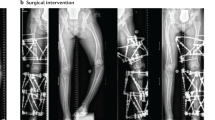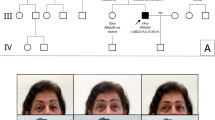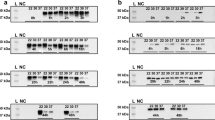Abstract
Cranio-osteoarthropathy, clinically classified as a variant of primary hypertrophic osteoarthropathy, is a very rare autosomal-recessive condition characterized by delayed closure of the cranial sutures and fontanels, digital clubbing, arthropathy, and periostosis. Recently, mutations in the gene HPGD, which encodes the NAD+-dependent 15-hydroxyprostaglandin dehydrogenase, were reported in four families affected with primary hypertrophic osteoarthropathy and one family with autosomal-recessive isolated nail clubbing. We report the clinical and molecular findings in four patients from two families affected with cranio-osteoarthropathy and one family with isolated, autosomal dominant digital clubbing. Genome-wide homozygosity mapping identified a locus for cranio-osteoarthropathy harboring the HPGD gene in one affected family. We detected two novel homozygous mutations in HPGD in these families: a missense mutation affecting the NAD+ binding motif and a frameshift mutation. The clinical presentation in our patients was variable. Digital clubbing and hyperhidrosis were present in all cases. Delayed closure of the cranial sutures and fontanels, periostosis, and arthropathy were not consistent clinical features. No HPGD mutation was detected in a familial case of autosomal dominant isolated digital clubbing. The failure to identify any mutation in a family with an autosomal dominant type of isolated digital clubbing suggests that HPGD is not the major gene for this condition.
Similar content being viewed by others
Log in or create a free account to read this content
Gain free access to this article, as well as selected content from this journal and more on nature.com
or
References
Castori M, Sinibaldi L, Mingarelli R, Lachman RS, Rimoin DL, Dallapiccola B : Pachydermoperiostosis: an update. Clin Genet 2005; 68: 477–486.
Latos-Bielenska A, Marik I Kuklik M, Materna-Kiryluk A, Povysil C, Kozlowski K : Pachydermoperiostosis-critical analysis with report of five unusual cases. Eur J Pediatr 2007; 166: 1237–1243.
Dabir T, Sills AM, Hall CM, Bennett C, Wilson LC, Hennekam RC : Cranio-osteoarthropathy in sibs. Clin Dysmorphol 2007; 16: 197–201.
Pillet P, Boralevi F, Chateil JF, Pinlou E, Lacombe D : Familial idiopathic hypertrophic osteoarthropathy and atopic dermatitis (Currarino's disease). Arch Pediatr 2002; 9: 921–924.
Currarino G, Tierney RC, Giesel RG, Weihl C : Familial idiopathic osteoarthropathy. Am J Roentgenol Radium Ther Nucl Med 1961; 85: 633–644.
O'Connell S, Suri M, Duff D, Kelleher J, Hall CM, Reardon W : Congenital cardiac disease as a core feature of cranio-osteoarthropathy. Clin Dysmorphol 2004; 13: 213–219.
Uppal S, Diggle CP, Carr IM et al: Mutations in 15-hydroxyprostaglandin dehydrogenase cause primary hypertrophic osteoarthropathy. Nat Genet 2008; 40: 789–793.
Coggins KG, Latour A, Nguyen MS, Audoly L, Coffman TM, Koller BH : Metabolism of PGE2 by prostaglandin dehydrogenase is essential for remodeling the ductus arteriosus. Nat Med 2002; 8: 91–92.
Tariq M, Azeem Z, Ali G, Chishti MS, Ahmad W : Mutation in the HPGD gene encoding NAD+ dependent 15-hydroxyprostaglandin dehydrogenase underlies isolated congenital nail clubbing (ICNC). J Med Genet 2009; 46: 14–20.
Hoffmann K, Lindner TH : easyLINKAGE-Plus--automated linkage analyses using large-scale SNP data. Bioinformatics 2005; 21: 3565–3567.
Lindner TH, Hoffmann K : easyLINKAGE: a PERL script for easy and automated two-/multi-point linkage analyses. Bioinformatics 2005; 21: 405–407.
Hoffmann K, Dreger CK, Olins AL et al: Mutations in the gene encoding the lamin B receptor produce an altered nuclear morphology in granulocytes (Pelger-Huet anomaly). Nat Genet 2002; 31: 410–414.
Cho H, Oliveira MA, Tai HH : Critical residues for the coenzyme specificity of NAD+-dependent 15-hydroxyprostaglandin dehydrogenase. Arch Biochem Biophys 2003; 419: 139–146.
Tariq M, Azeem Z, Ali G, Salman Chishti M, Ahmad W : A mutation in HPGD gene encoding NAD+-dependent 15-hydroxyprostaglandin dehydrogenase underlies an isolated congenital nail clubbing (ICNC). J Med Genet 2009; 46: 14–20.
Coggins KG, Coffman TM, Koller BH : The Hippocratic finger points the blame at PGE2. Nat Genet 2008; 40: 691–692.
Acknowledgements
We are grateful to all patients and their families for their collaboration. We thank FAM Hennekam for performing genealogical studies in family 2, RCM Hennekam and J Kuehnisch for helpful discussion throughout the project, and P Meinecke for critically reading the paper. The SNP typing was performed by the Microarray Facility in Tübingen.
Author information
Authors and Affiliations
Corresponding author
Additional information
Supplementary Information accompanies the paper on European Journal of Human Genetics website (http://www.nature.com/ejhg)
Supplementary information
Rights and permissions
About this article
Cite this article
Seifert, W., Beninde, J., Hoffmann, K. et al. HPGD mutations cause cranioosteoarthropathy but not autosomal dominant digital clubbing. Eur J Hum Genet 17, 1570–1576 (2009). https://doi.org/10.1038/ejhg.2009.104
Received:
Revised:
Accepted:
Published:
Issue date:
DOI: https://doi.org/10.1038/ejhg.2009.104
Keywords
This article is cited by
-
A Common Mutation and a Novel Mutation in the HPGD Gene in Nine Patients with Primary Hypertrophic Osteoarthropathy
Calcified Tissue International (2015)
-
Primary hypertrophic osteoarthropathy caused by homozygous deletion in HPGD gene in a family: changing clinical and radiological findings with long-term follow-up
Rheumatology International (2014)



